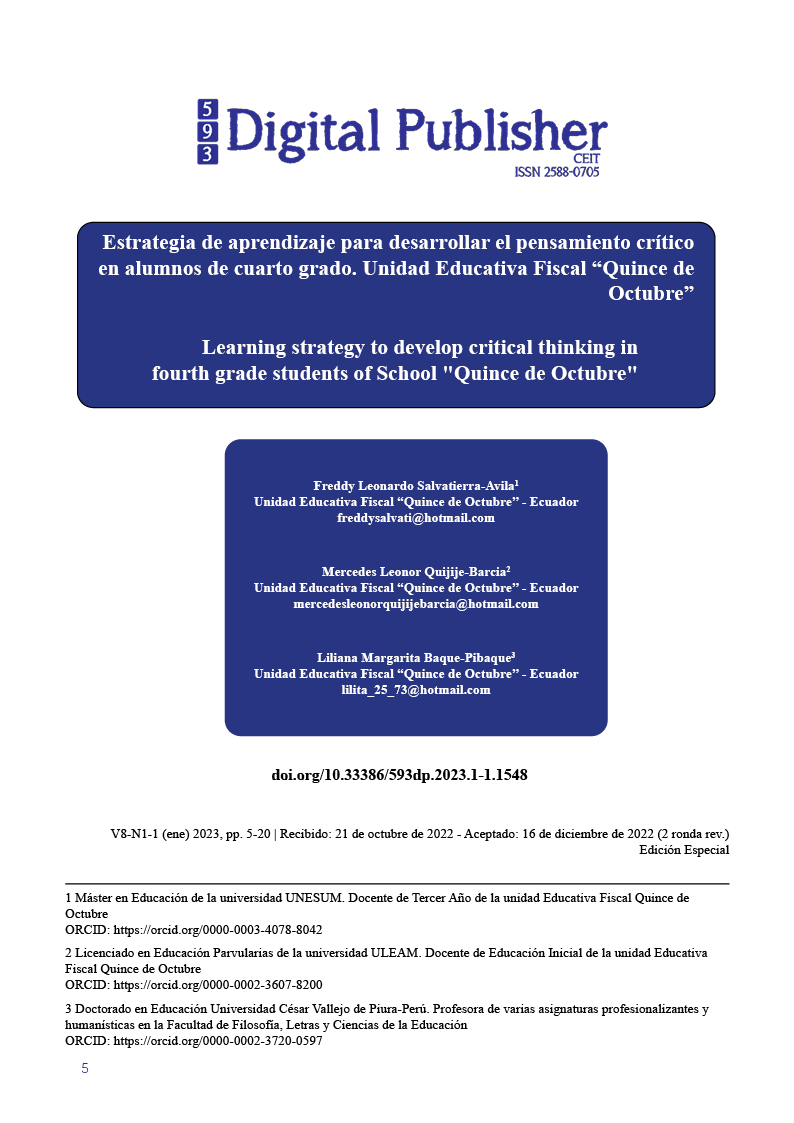Learning strategy to develop critical thinking in fourth grade students. Tax educational unit "fifteen of October".
Main Article Content
Abstract
Competency based education seeks to develop cognitive skills that allow students to generate critical thinking that translates into the ability of students to solve problems inside and outside the classroom. The main objective of this research project is to design a learning strategy to develop critical thinking in fourth grade students of the Fiscal Educational Unit "Quince de Octubre". In this sense, it is necessary for teachers to take advantage of the various moments of work in the field of education and be able to introduce or develop strategies to cultivate this criticality in students. Hence the importance of understanding the dimensions of reasoning, the criteria and intellectual elements necessary to develop critical thinking, and analyzing strategies to encourage active and reflective participation based on the academic level of students, since, by developing critical thinking it is a strategy that benefits learning in general. Therefore, the teaching of students and the methods of teachers must be transformed, that is, take a turn to change the routine memorization for critical thinking to face changes and contribute with new and creative ideas. This is why this research was educational because it adopts a dialectical perspective, using both quantitative and qualitative methods to study educational phenomena. In the field diagnosis, different methods, techniques and tools are applied to verify the objectivity of the problem. Both theoretical and practical approaches allow to identify causes, consequences and design instructional strategies based on systematic scientific references in a theoretical framework to guide the teaching process to better understand their potentialities, abilities, needs and therefore the increase of participation. of the students.
Downloads
Article Details

This work is licensed under a Creative Commons Attribution-NonCommercial-ShareAlike 4.0 International License.
1. Derechos de autor
Las obras que se publican en 593 Digital Publisher CEIT están sujetas a los siguientes términos:
1.1. 593 Digital Publisher CEIT, conserva los derechos patrimoniales (copyright) de las obras publicadas, favorece y permite la reutilización de las mismas bajo la licencia Licencia Creative Commons 4.0 de Reconocimiento-NoComercial-CompartirIgual 4.0, por lo cual se pueden copiar, usar, difundir, transmitir y exponer públicamente, siempre que:
1.1.a. Se cite la autoría y fuente original de su publicación (revista, editorial, URL).
1.1.b. No se usen para fines comerciales u onerosos.
1.1.c. Se mencione la existencia y especificaciones de esta licencia de uso.
References
Beltran. (2019). ESTRATEGIAS DE APRENDIZAJE QUE UTILIZAN LOS ALUMNOS UNIVERSITARIOS . Obtenido de http://www.editorial.unca.edu.ar/Publicacione%20on%20line/DIGITESIS/Curotto%20Margarita/pdf/capitulo-3.pdf
Cangalaya Sevillano, L. M. (Junio de 2020). Habilidades del pensamiento crítico en estudiantes universitarios a través de la investigación. Obtenido de http://www.scielo.org.pe/scielo.php?pid=S2415-09592020000100141&script=sci_arttext
Castellví Mata Jordi, M. S. (2019). Revista de Investigación en Didáctica de las Ciencias Sociales. Obtenido de Emociones y pensamiento crítico en la era digital: un estudio con alumnado de formación inicial: https://mascvuex.unex.es/revistas/index.php/reidics/article/view/2531-0968.05.23
Edacom. (15 de Noviembre de 2019). ¿QUÉ ES EL PENSAMIENTO CRÍTICO Y POR QUÉ ES IMPORTANTE? Obtenido de https://blog.edacom.mx/que-es-pensamiento-critico-por-que-es-importante
Elder, P. &. (5 de 09 de 2018). La mini-guía para el pensamiento. Obtenido de https://scholar.google.es/scholar?hl=es&as_sdt=0%2C5&q=PAUL%2C+R.%2C+%26+ELDER%2C+L.+2003.+La+mini-gu%C3%ADa+para+el+pensamiento+cr%C3%ADtico%2C+conceptos+y+herramientas.+California%3A+Fundaci%C3%B3n+para+el+pensamiento+cr%C3%ADtico.+%28USA%29&btnG
Gómez, J & Gómez,L. (2017). Elementos teóricos y prácticos de la pedagogía crítica: Más allá dela educación, metáfora, escena y experiencia. Praxis, 66,181-189.
HERNÁNDEZ, J. A. (15 de Diciembre de 2019). Docentes al Día. Obtenido de ¿Qué son las estrategias de aprendizaje? definición, tipos y ejemplos: https://docentesaldia.com/2019/12/15/que-son-las-estrategias-de-aprendizaje-definicion-tipos-y-ejemplos/
INJOQUE, J. (2 de 10 de 2017). "Ensayo sobre el aprendizaje". Obtenido de https://ensayoscortos.com/ensayo-sobre-el-aprendizaje/
Lizarazo García, N. Y. (11 de 07 de 2022). Aprender a pensar: Propuesta para la estimulación del pensamiento crítico en niños. Obtenido de file:///C:/Users/LENOVO/Downloads/2022_Tesis_Nasli_Lizarazo.PDF
López Ruiz Carolina, F. F. (2021). Pensamiento crítico en estudiantes de educación superior: una revisión sistemática. NOVVA ECUADOR, http://www.revistainnovaeducacion.com/index.php/rie/article/view/229. Obtenido de Pensamiento crítico en estudiantes de educación superior: una revisión sistemática.
Mora, Y. (26 de Noviembre de 2020). CENTRO SUR. Obtenido de La eficacia de la docencia en la educación universitaria desde la perspectiva del pensamiento critico. : http://portal.amelica.org/ameli/jatsRepo/384/3841574015/3841574015.pdf
RIVERA, A. (15 de Agosto de 2018). Estrategias cognitivas del aprendizaje. Obtenido de https://es.slideshare.net/ADALMISRIVERA/estrategias-cognitivas-del-aprendizaje
RODRIGUEZ, H. (29 de OCTUBRE de 2021). ¿Qué es el pensamiento crítico? . Obtenido de https://www.crehana.com/blog/marketing-digital/que-es-y-para-que-se-usa-el-pensamiento-critico/
Valle Antonio, G. R. (2018). Las estrategias de aprendizaje: características básicas y su relevancia en el contexto escolar. Revista de Psicodidáctica, https://www.redalyc.org/pdf/175/17514484006.pdf.
VALLE, A., & GONZÁLEZ, R. (2018). Las estrategias de aprendizaje : características básicas y su relevancia en el contexto escolar. Redined.
VALLE, T. (2017). EL DESARROLLO DEL PENSAMIENTO CRÍTICO EN LENGUA Y LITERATURA Y SU INCIDENCIA EN EL. Obtenido de https://repositorio.uta.edu.ec/bitstream/123456789/5545/1/TESIS.pdf
Yarlequé Chocas Luis Alberto, A. e. (2020). Obtenido de Pensamiento Crítico, Resolución de problemas y Comprensión lectora en ingresantes a la universidad: https://revistas.uncp.edu.pe/index.php/socialium/article/view/604
Zelaieta Anta, E. (Septiembre de 2018). Revista Complutense de Educación. Obtenido de Juego de rol para el desarrollo del pensamiento crítico en la formación: file:///C:/Users/LENOVO/Downloads/lsantoso,+1_RCED_vol_30_3_2019_729_745.pdf




